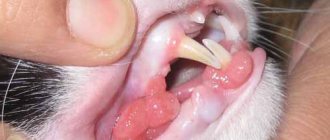Hello, dear cat lovers!
What to do? The first is not to go to two extremes: do not panic and do not ignore, the second is to go for an examination, which will show the further plan of action. It will directly depend on the reasons for the appearance of the bump, and there are a lot of them!
We will look further into why a cat has a large lump on its stomach that suddenly appeared, without letting this problem go by itself.
Cancerous degeneration of the mammary glands
Let's start with the most terrible diagnosis. How can you avoid a sad outcome? It has long been known: if you detect trouble at the very beginning!
Breast cancer is recognized by this sign: the tumor grows quickly, and there is usually more than one of it, because “trouble never comes alone”: the number of smaller swellings also increases quickly, and the localization sites at first are near the nipples closer to the groin.
These warning signs are a reason to run to the vet!
Then the bumps become dense, bleeding, painful, with a purple-pink tint. The photo shows a severe case, but don’t worry, it can be eliminated:
Since at the beginning of the disease the cat’s health is normal, as the disease progresses, it will begin to lose weight and lose appetite, and this is the second threatening “marker”! Therefore, in order not to start a tumor, to successfully get rid of it and thereby save the life (!) of your pet, you need to examine and feel its body more often in order to see a doctor early.
The photo shows the view after a successful operation:
Treatment, even in an advanced form, sometimes (but not always!) helps to prolong life by several months and reduce discomfort in this condition.
At risk are older and unsterilized animals (who are given “Sex Barrier” and all other anti-estrus drugs, the instructions for which always (!) contain a warning about the danger of oncology, even from several uses - from 1 to 3 times!).
Veterinarian advice: you need to sterilize your ward at 11-12 months, when the genitourinary system has formed, or between the first and second estrus, first having received the necessary vaccinations, and from the age of 6 - regular examination in the form of medical examination for early diagnosis of cancer, if it decides to start in your tail!
Correct treatment
The therapy prescribed by a veterinarian depends on the diagnosis, stage of the disease and the state of the immune system.
Breast cancer detected at an early stage is treated with special medications. At the same time, fixation of the disease in the later stages has a sad prognosis and is based on anesthesia and subsequent euthanasia.
If bumps appear on your pet, it is best to contact your veterinarian immediately.
During surgery, the operated cat is entitled to:
- taking immunomodulators;
- radiation or chemotherapy to get rid of the disease;
- a course of antibiotics to suppress the infection.
To treat the remaining wound, use healing ointments and monitor the condition of the bandage.
Some lesions do not require treatment and are removed only if they cause inconvenience in everyday life. For example, in case of a hernia that is interfering with the animal, massage sessions or repositioning of the prolapsed organ after removal of the hernial lump are used.
Among the listed diseases, mastitis is subject to mandatory treatment, suggesting:
- novocaine blockade;
- physiotherapy;
- surgical intervention (for advanced cases);
- compresses and antibiotics.
Don't hesitate to contact your veterinarian. Some tumors found in cats pose a serious danger to humans.
What to do if the bumps bleed or fester
If the tumor bleeds or pus appears, you should urgently take the animal for a veterinary examination. These symptoms indicate the presence of cancer.
The appearance of pus from the cones indicates the development of cancer
Before visiting a doctor you should not:
- use ointments without prior consultation;
- treat the formation with a solution containing alcohol;
- wash or wet the tumor;
- puncture the seal or try to squeeze it out.
If a lump on the stomach breaks, provide first aid by treating it with an antiseptic without alcohol, and be sure to take the cat to the doctor.
Benign tumor
This is a lipoma (or wen). It is enclosed in a capsule, has clear boundaries and, unlike malignant tumors, does not tend to grow quickly, is round or oval, soft to the touch, and moves under the skin.
It is usually monitored, and if removed, it is only in extreme cases - for example, if it is too large, interferes with the cat's daily activities, or is itchy. Although it is not fatal, it is necessary to show it to a doctor to confirm this particular diagnosis:
Diagnostics
An experienced veterinarian will immediately determine which direction the neoplasm belongs to, but additional examinations will still need to be carried out to clarify the specifics and adjust further treatment.
To make a diagnosis you need to undergo a comprehensive examination
To make an accurate diagnosis, the doctor will collect an anamnesis, find out the age of the animal, what kind of illness it had, what chronic diseases and health problems there are. Afterwards, the doctor examines the neoplasm itself, finds out how long ago it appeared and whether it bothers the pet.
After a clinical examination of the animal, the doctor will collect a general analysis of urine and blood, examine the heart, do an X-ray and an ultrasound to study exactly where the tumor is located and what its structure is.
Important! As a rule, all neoplasms that are benign have clear contours, smooth on the surface and not very dense. Malignant tumors without a definite shape, lumpy and rapidly growing in size.
If we are talking about a malignant neoplasm, then perhaps the doctor will prescribe a tissue biopsy for cytology.
Recently, there has been a tendency towards the frequent appearance of neoplasms in domestic animals. They can be life-threatening for the pet, or they can be harmless, but in any case, if a lump is detected, you should not hesitate. If, after sterilization, a cat has a lump on the seam, the animal should be taken to the doctor for treatment, and possibly new stitches.
Hernia
This unpleasant pathology lies in the fact that parts of the internal organs of the peritoneum penetrate into adjacent cavities through natural or abnormal openings. Both adult cats and their babies can suffer from it!
Let's start with umbilical hernia in kittens. Here it is clearly visible on the belly of the baby sphinx:
Through an umbilical ring that is not completely closed (due to genetic disorders or improper cutting of the umbilical cord), a loop of intestine falls into the “hernial sac”:
This hernia in the Sphinx is reducible. But only if it is not pinched! Otherwise, the blood flow in it is disrupted, which will cause tissue death (!), then inflammation in the peritoneum, which will turn into peritonitis, then the cat will die.
Sometimes a kitten’s hernia does not fall out immediately, but will be triggered later, for example, by constipation.
In adults, the tumor is most often located in the groin area, has a size from a small lump to an egg-shaped lump, can be soft or hard, and has a body temperature or higher.
Formed recently, it can go unnoticed for some time, because it does not yet cause anyone any discomfort, but in its neglected state it is a rather large, round swelling, soft or elastic to the touch.
The situation is worse if the hernia is pinched, then the cat will feel constant pain, often meow, cower, arching its back. There will be problems with stool and urination, sometimes vomiting, fever, lethargy, and possible disturbances in gait and coordination. Surgery is inevitable!
Predisposed animals are those with:
- genetic inheritance;
- digestive problems: constipation and increased gas formation;
- cutting the umbilical cord too short;
- peritoneal injuries: blows, bruises, bites, etc.
Of course, you cannot “treat” yourself with decoctions, compresses, set internal organs, or wait until “it goes away on its own”!
Only a specialist can make the correct diagnosis, perhaps with the help of an x-ray or ultrasound. And after the reduction, a bandage will be put on the pet for 3-4 weeks to prevent relapses.
You can do without surgery if the tumor is small, but you will have to eliminate it if it is diaphragmatic or intervertebral. And then the following are prescribed: immunomodulatory and anti-inflammatory drugs; a diet that eliminates constipation; ban on active games for 2 weeks.
Types and signs of subcutaneous formations
Subcutaneous neoplasias (tumors) can be benign or malignant. The former pose a danger only if they grow to large sizes and begin to infringe on nearby organs. Malignant formations (sarcomas and fibrosarcomas) cause cell degeneration, metastasis and therefore often lead to the death of the animal.
Benign subcutaneous tumors, depending on the histological structure and causes of formation, are divided into several categories:
- Hematoma. This is a painful lump caused by damage to small vessels due to injury. Usually has a purple color (“bruise”), as it is an accumulation of blood under the skin, and may be accompanied by a local increase in temperature. The hematoma can fester, forming a cyst.
- Post-injection infiltrate. A small lump formed at the injection site. If there is no infection, it practically does not cause any disturbance in the animal’s well-being and resolves on its own.
- Lipoma (“wen”), a subcutaneous lump that is soft to the touch and prone to growth. Such a ball under the skin of a cat easily moves when pressed, without causing any discomfort. These neoplasms form from connective tissue in areas where fat cells are abundant and are often found on the abdomen of older animals.
We suggest you read: Eclampsia in cats - symptoms, causes and treatment
Lipoma (wen) in cats
- Cavernous hemangioma. Vascular proliferation, which is a soft, lumpy nodular formation of a bright red or blue-purple color.
- Syringoepithelioma. This is a modified element of part of the sweat gland in the form of a nodule up to 1.5 cm in size. The skin over the lump usually retains its normal color, and the tumor itself does not cause concern to the animal: it does not hurt or itch. In cats, this type of neoplasm often forms on the abdomen.
- Abscess (ulcer, abscess). The cause of the development of an abscess can be a wound, an insect bite, an unsuccessful injection or scratching on the skin (for example, with “cat scabies” - notoedrosis). The condition for abscess formation of a seal on the neck, abdomen or head of a cat is that the damaged skin gets infected with a bacterial infection. Ulcers are painful and can cause fever and fever.
- Cyst. This is the name of a round-shaped capsule filled with serous contents. Such “balls” can be located on any part of the cat’s body; their sizes vary from 2-3 mm to several centimeters. Cysts grow slowly and are usually painless. Most often, these tumors are harmless and are formed as a result of blockage of the sebaceous gland (atheroma, pilar cysts) or lymph node.
A cyst on the head of a cat. Of unknown origin, a small lump similar to a ball under the skin on the neck or head of a cat may be a tick that has penetrated and fed on blood. It must be carefully removed entirely so that the remaining part of the insect under the skin does not lead to the development of an abscess. The lump can also form as a result of a small foreign body getting under the cat's skin. In the subcutaneous tissue, the foreign body is encapsulated and looks like a round solid formation.
The cause of the appearance of a lump under the skin of a cat can be cancerous tumors, lymphadenitis, hernias, benign tumors (lipomas, wen, papillomas, fibromas).
Cats are often diagnosed with lumps under the skin that develop as a result of inflammatory processes of the skin - furunculosis, folliculitis, carbuncles, abscesses, and phlegmon. The cause of a cone in a cat can also be the bite of a poisonous insect - a wasp, bee or bumblebee.
Depending on what type of tumor the animal has under the skin, the symptoms will be different. If a ball is found under the skin of a cat's neck, the cause may be a benign or malignant tumor. The main signs of benign neoplasms are:
- long-term development;
- a clear boundary between healthy and modified tissue structures;
- presence of encapsulation;
- absence of metastases;
- roundness of shape and smoothness of surface.
Malignant neoplasms are characterized, on the contrary, by rapid growth, the presence of sites of stasis and the occurrence of ulcerations. Balls under the skin associated with malignant tumors have a bumpy surface with areas of necrosis of tissue structures.
A tumor diagnosed under the skin on the cat’s abdomen may well turn out to be a benign formation – a lipoma. The main differences between this neoplasm and a malignant one are the absence of rapid growth, soft structure, and roundness of shape.
A characteristic feature of a lipoma is its ease of movement, as if a ball were rolling under the skin of a cat. Lipoma does not require immediate removal. In the vast majority of clinical cases, the neoplasm is systematically monitored by specialists.
Surgical intervention is prescribed only if the location of the lipoma begins to cause discomfort to the animal - it itches, greatly increases in size, and in every possible way interferes with the cat’s usual activities.
To differentiate a lipoma from a possible malignant neoplasm, it is advisable to perform a biopsy, as well as laboratory tests of the animal’s blood and urine.
We invite you to familiarize yourself with: Super premium food - the best for domestic cats
Mastitis
It is a consequence of early weaning from a nursing mother, sometimes - diseases of the genital organs, damage to the nipples or false pregnancy.
The mammary glands become inflamed and swollen, become hard and hot, and the body temperature rises. This is what a Sphynx cat looks like:
If a nursing female is sick, milk may not be released or will come along with pus. The doctor, after the necessary tests, will make sure that there is no cancer and will prescribe treatment.
If the illness is mild, he will prescribe compresses and massages at home; if it is severe, he will prescribe medications, including antibiotics, or even surgery.
Hygroma
Or a synovial cyst is a swelling of tissue with saturation with serous fluid.
It looks like a painless swelling with fluid inside, but if an infection joins it, ulcerations and discharge appear. And when it grows to a large size, it can interfere and hurt when moving.
The veterinarian may prescribe removal of the contents of the cyst and the introduction of anti-inflammatory drugs in its place, but surgery is rare.
Furuncle
This is not just an abscess - inflammation of the epithelium, but a disease (in acute or mild form) caused by decreased immunity and focal damage to the hair follicle. It is purulent and necrotic in nature, caused by white or aureus staphylococcus, and begins with a red tubercle:
Gradually, the sore increases, fills with pus, becomes painful, body temperature rises, apathy and loss of appetite are possible. The lesions affect some or all parts of the body, or isolated ones.
Under the skin, the pus is located, as it were, in a “vessel” that restrains the boundaries of inflammation, and after “ripening” one (or several) gray dots will be visible from above - the rod.
Do not squeeze out the boil! Otherwise, the pus will spill over the adjacent tissues.
The veterinary clinic will do everything you need, and in the case of a chronic form, they will prescribe antibiotics.
Keep a sick animal especially clean by placing disposable diapers on top of the bedding every day. Don't bathe! Trim the fur from the site of inflammation, apply ichthyol ointment or Vishnevsky, wipe with alcohol while changing the compress, give an anesthetic. In case of spontaneous opening of the sore, clean it as much as possible from pus (do not press!) and reapply a bandage with ointment, changing it every 4-6 hours until the wound is completely cleansed.
Abscess
This is a localized inflammation on the surface of the skin or deep in the tissues that can seriously threaten your pet's health if left untreated.
The most common causes are infection in wounds received by the cat in a variety of ways, which is why you can find swelling (with a purulent capsule inside) anywhere.
At this stage of edema and suppuration, urgent qualified help is needed, otherwise there is a risk of blood poisoning and death.
And we have all known prevention since childhood: immediately wash and disinfect any wounds that arise! How? Peroxide is better, others will cause a burn.
What diseases can be caused
There are many diseases that cause a lump on the neck. Interstitial fluid, immune cells, and blood accumulate inside it. Each cause has a different treatment and must be diagnosed. The sooner this is done, the higher the chance of saving the cat’s life and health.
A lump under a pet's jaw should alert any owner
A benign neoplasm is an increase in the number of different tissues that lead to a tumor. Benign means there are no stem cells that can spread throughout the body, causing metastases and organ damage. The tumor itself is not dangerous, but as it grows, the nervous and vascular tissues are compressed and neighboring organs are damaged.
A malignant tumor on the neck of a cat is the presence of mutated cells similar in structure to stem cells. They gradually multiply and increase in size. When cancer migrates through blood vessels, metastases form in the kidneys, liver, and brain. There they lead to dysfunction and gradual death of the animal.
Important! Both conditions are similar in the initial stages. Tumors can also develop on the neck, forming a lump.
Lipoma
Lipoma is a benign neoplasm. The lump appears due to the accumulation of fat cells that form a capsule around themselves. The formation is not dangerous until it begins to compress the blood vessels and nerve tissues in the neck. If it reaches a large size, it can make it difficult to breathe and move food through the esophagus.
Abscess
An abscess is an accumulation of fluid in a capsule. It can develop in any part of the body. An abscess is dangerous because purulent exudate can accumulate inside it, the capsule will burst, and the liquid will spread throughout the intercellular substance, entering the vessels. This will cause sepsis and death of the cat without long-term treatment.
Inside the abscess there is interstitial fluid with admixtures of immune cells that have penetrated into the cavity. A ball appears on the neck under the skin of a cat, which can occur as a result of mechanical damage, inflammatory and infectious processes, compression of tissue by a collar and other reasons.
Abscess
Lymphadenitis
The disease occurs due to excessively enlarged lymph nodes. They can hypertrophy due to the following reasons:
- mycobacteria;
- fungi;
- parasites;
- bacteria;
- viruses.
Note! Lymph nodes cannot develop to enormous sizes with a single exposure to a pathogenic microorganism. The cat must often suffer from diseases, which will gradually lead to an increase in tissue. It can grow to such a size that it interferes with normal chewing of food, breathing, and blood circulation.
Ixodid tick
The parasite lives in plants, it clings to the animal’s fur, gradually moving to its skin. The tick attaches itself through the skin, feeding on blood. Many species of ixodid ticks carry borreliosis, hemorrhagic fever, and meningoencephalitis.
Some types of ticks carry infections, viruses that lead to the formation of bumps on the skin. This is a focus of inflammation in which immune cells, tissue fluid, and pathogens accumulate.
Important! The immune system actively fights the infection, lymphocytes release inflammatory mediators, which further enlarges the lump on the cat’s neck.
Some cats may live outside temporarily or permanently. There are also insects that inject poison when they bite an animal. This causes an immune reaction. Lymphocytes, eosinophils, and mast cells accumulate in the lesions. They begin to release inflammatory mediators, which forms a tumor on the cat’s neck.
Note! Many owners notice that their cat's neck is swollen after being scratched. If it is not treated, an infection may enter the wound, which will also cause an inflammatory reaction and swelling.
Mastitis
Mastitis can occur due to severe cold in the cat or due to stagnation of milk. The condition leads to an inflammatory reaction in the mammary glands. The tissues increase greatly in size. Immune cells move there. They can accumulate above the source of inflammation in the neck. Therefore, when owners see a lump under the cat’s jaw, they wonder what it is.
The mammary glands become coarser, lumps appear in them, which are not eliminated with a light massage. They cause acute pain, increased body temperature, weakness, fatigue, lethargy, and drowsiness in the cat. The appetite disappears, the animal constantly sleeps.
Hematoma
With strong impacts or compression of soft tissues, hematomas can occur. This is a collection of blood under the skin. If there is enough liquid, it accumulates in the form of lumps.
Some hematomas may disappear on their own; the blood gradually resolves. But if the formation increases, it is better to contact a veterinarian so that he can suck out the liquid using a syringe.
Insect bite
No, not butterflies. Painful swelling can only be caused by the bite of stinging insects!
Remove the sting with tweezers, rinse with a soda solution (a teaspoon per glass of water) and apply a cold compress to relieve swelling.
To prevent allergies, give ¼ tablet of Tavegil or Suprastin twice a day, and if the condition worsens, go straight to the clinic, and even more so if there are a lot of bites, because then death is not far away.
Lymphadenitis in cats
A lump may appear on a cat's stomach if the inguinal lymph node becomes inflamed. The cause is an infection leading to diseases of the genitourinary system. With lymphadenitis, compaction is characterized by the following features :
- oblong shape;
- soreness;
- immobility;
- the skin over the bump is hot.
If such a tumor is discovered, the cat should definitely be shown to the doctor. The disease that causes lymphadenitis requires treatment. Antibiotics, anti-inflammatory drugs, preparations with vitamins, iron, magnesium, potassium and other beneficial substances that help strengthen the immune system may be indicated.
Symptoms of lymph node inflammation are similar to cancer. Cancer can only be ruled out by diagnostics, so a trip to the clinic is essential.










